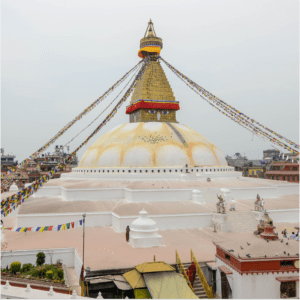Teenagers aged 11-18 from the Mountain Children Home share the beauty of Nepal

Boudhanath ( बौद्धनाथ) is a stupa in Kathmandu, Nepal. It's the largest single Chhyorten in the world.
March 1, 2024
10 things you should know about Nepal
Harbingers’ Magazine has been teaching journalism to several children from the Mountain Children Home, an orphanage in Dadagaun, a village in the hills north of Kathmandu. We asked them to tell us about their country: this is what they said.
1. A landlocked country
Nepal is a landlocked country at the foot of the Himalayan mountains. Over 30mn people live in Nepal, and the country depends upon neighbouring countries for the resources needed to survive.
Spreading across almost 150,000 square kilometres it is roughly the size of Kazakhstan or the state of Iowa in the United States. Nepal is almost 650 kilometres away from the nearest seashore (the Bay of Bengal in the Indian Ocean).
Nepal is sandwiched between two giant countries; China in the north and India in the south, east and west. It is divided into three geographical regions – the mountains, hills and the Terai.
By Kalpana B.K (aged 11)
2. Three geographical regions
The mountain region lies in the northern part of Nepal. It is the least developed because the temperature there is very low.
Eight of the ten tallest mountains in the world, including Mount Everest (in Nepali, Sagarmāthā (सगरमाथा), ‘The Head in the Great Blue Sky’), are found in the mountain region of Nepal, which covers almost 52,000 square kilometres.
The altitude of the mountains ranges from 4,800–8,848 metres above sea level. Many Mongolians – with surnames such as Sherpa, Tamang, Gurung and Rai – live in the Himalayan region.
The Himalayas are one of Nepal’s treasures, as many tourists come solely to climb these mountains with around 35,000 people visiting Mount Everest each year.
The Hilly region lies in the central part of Nepal and is more developed than the mountains. It includes the Kathmandu Valley, the country’s most fertile and urbanised capital area.
Hilly culture and society are based on geological conditions. Dhindo and gundruk are famous foods among the farming families in Hilly regions (areas of land that are higher than the surrounding land).
Several ethnic groups live together in the middle hills and valleys. Among them are the Magars, Gurungs, Tamangs, Sunuwars, Newars, Thakalis and Chepang.
The Terai (plains) is a lowland region in northern India and southern Nepal covering 17% of the country. With a very hot climate, farming is mainly limited to sugarcane, cardamom and fruit. The population living in the Terai region are mostly Tharus, Darai, Kumha and Majhi as well as migrants from India.
By Samuna B.K (aged 12)
3. Nepal’s flag
Nepal’s flag is very different from those of other countries because it is made up of two triangles. While other countries’ flags are rectangular, ours is the only triangular flag in the world, making our country unique.
The flag contains three colours – blue, white and crimson red – plus a moon in the upper triangle with a sun in the lower one. The crimson red symbolises bravery and represents the rhododendron, which is Nepal’s national flower. The blue border is the colour of peace.
By Pratima Chaudhar (aged 13)
4. Birthplace of Buddha
Buddha is another name for Siddhartha Gautam, who was born about 2,500 years ago in Lumbini, in the Kapilvastu district of Nepal.
He was the son of King Suddhodhana and Queen Maya Devi, who died after her son was born. King Suddhodana and his other wife, Maha Prajapati, raised Buddha. His father didn’t let him go out and be among the poor people. He married a princess called Yasodha, and they had a son called Rahul.
He became a wise man and is still known as the light of Asia. People called him the Buddha (‘the awakened one’). Buddha taught people how to be happy, and Buddhists all over the world follow his teachings.
By Om Lal Shrestha (aged 18)
Read more:
‘Nepal is an independent, indivisible sovereign, secular, inclusive, democratic, socialism oriented and federal democratic republican state. Nepal is the country with multi-ethnic, multilingual, multireligious, multicultural characteristics, which ensembles the idea of Unity in Diversity’
By the Department of Information and Broadcasting | Government of Nepal
5. Nepal’s pluralistic society
Nepal is a multicultural country because its citizens are from different ethnic groups with different traditions – a multi-ethnic, multilingual and multi-religious society. Nepal’s people have different religions, cultures, languages, castes and celebrate different types of festivals according to their norms, values and beliefs.
Nepal’s different cultures live in ‘unity in diversity’; they all live as different flowers in a garland. The constitution of Nepal declares that “all languages spoken as the mother tongues in Nepal are the languages of the nation.”
As Nepal is a secular state, all religions are respected by the government. Nepali national identity depends on this cultural and ethnic diversity.
By Santoshi Gurung (aged 14)
6. Tihar festival
Tihar, also called the Festival of Lights (Diwali in India), is a very important event for Nepal. It falls around the months of October and November. During the festival, Nepali make their surroundings as bright as possible, even the slightest patch of darkness cannot be found.
Tihar lasts for five days. On each day, people worship different animals and goddesses.
For the first day they worship crows, because they are considered to be messengers of Yama (god of death). They believe that by giving food to crows they will protect their homes from negative energies and bad omens
For the second day, they worship dogs because they are known for their loyalty and companionship. They decorate their dogs with flower garlands and tika (a red vermilion mark) on their foreheads. Dogs are also given treats and special meals. Nepali believe that dogs will guard them against hell after death.
For the third day, they worship cows because they are a sacred animal in Hinduism and they symbolise wealth, prosperity and motherhood. They also worship Laxmi (goddess of happiness) in the evening.
A special dish called sel roti (a ring-shaped sweet fried dough, made from rice flour) is made during the celebration and in the evening, they start to sing Bhailo (folk songs) and dance. People dancing and singing go to different houses to receive rice and some money from the owner.
On the fourth day they worship the ox, as it is known as the backbone of farming in Nepal.
The fifth day is a day of special celebration for the bonds between sisters and brothers and unity within the family. Sisters worship their brothers. They wish their brothers a long life and give them special food. In exchange, the brothers give their sisters money or gifts.
By Ramita Chadaxa (aged 13)
7. Federal democratic republic country
Nepal’s government system is federal, meaning that there are two or more levels of government within the country. The United States of America and India for example have three tiers of government.
In Nepal, the power, authority and resources at the centre are distributed among the federal, provincial and local levels, as mentioned in the constitution. In federalism there is an arrangement to provide essential service of the people to their government.
By Binita Nepali (aged 14)
8. A country of beautiful lakes
Rara Lake is the largest and deepest lake in Nepal. It is the main feature of Rara National Park, one of the country’s most famous trekking destinations. It is around 5 kilometres long, at an altitude of 2,990 metres.
Phewa Lake is located in the southern part of Pokhara Valley and is the second-largest lake in Nepal. It is approximately 4 kilometres long, at an altitude of 742 metres. It is the most-visited lake in Nepal as well.
Begnas Lake, also in the Pokhara Valley, is the third-largest lake in Nepal and famous for its delicious fish.
Rupa Lake is one of Nepal’s main tourist attractions. It is famous for fish farming, and visitors can take a boat trip to see the paddy fields around it. It covers an area of 1.35 square kilometres, at an altitude of 600 metres.
Shey Phoksundo Lake is an alpine lake with a magnificent turquoise colour and spectacular scenery.
By Rakshya B.K (aged 12)
9. World Heritage Sites
Nepal has several UNESCO World Heritage Sites.
Pashupatinath Temple is the oldest Hindu temple in Kathmandu and is devoted to Pashupatinath (an avatar of Shiva). According to the Nepal story Devi Mahatmya and Himvathanda, the temple’s existence is recorded as early as 400 CE
Boudhanath Stupa is constructed in a mandala style (a circular image meant to reflect the nature of the universe). It is a three-dimensional reminder of the Buddha’s path towards enlightenment.
The stupa is split up into four different areas, which symbolise different things. The base is a symbol of the earth. The kumbhu (white dome) symbolises water. The spire at the top symbolises air. The top-most umbrella shape symbolises the void.
Swayambhunath Stupa, one of the crowning glories of Kathmandu Valley’s architecture, was built by King Mandev during the early fifth century. This perfectly proportioned monument has a gilded spire, from which four faces of the Buddha stare out.
Kathmandu Durbar Square is one of three Durbar Squares (royal palaces) constructed by Malla King between the 12th and 18th centuries in the Kathmandu Valley. It is also known as the Museum of Temples because there are so many temples in the square.
Lumbini has a garden in which Siddhartha Gautam (Lord Buddha) was born in 623 BC. This garden then became a place for pilgrims to worship the Lord.
Chitwan National Park is the first national park in Nepal, established in 1973. It covers an area of 952.63 square kilometres sitting at the base of the Himalayas.
By Laxman B.K (aged 11)
10. Adventurous tourism
Trekking and peak climbing are the most popular activities for tourists in Nepal. The country is a paradise for both novices and experienced climbers, as it offers the thrilling opportunity to climb an 8,000 metre mountain.
White water rafting on Himalayan rivers is also a thrilling and popular activity. It will take you through villages and forests, and is a good way to experience the wildlife in Nepal. Jungle safaris in the Terai region are another popular way to see Nepal’s rare and special animals while exploring national parks. Enjoy an unforgettable journey through the lush green forest on the back of an elephant, crossing rivers and swamps and observing the country’s marvellous flora and fauna – possibly even a royal Bengal tiger.
Nepal offers an extensive list of adventurous activities such as canyoning, mountain biking, rock climbing, bungee jumping, horse riding, snowboarding, fishing, birdwatching and even honey hunting.
By Suraj Tamang (aged 15)



